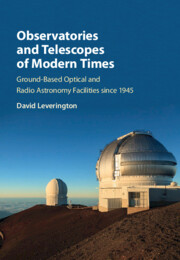 Observatories and Telescopes of Modern Times
Observatories and Telescopes of Modern Times from Part 1 - Optical Observatories
Published online by Cambridge University Press: 15 December 2016
ARC 3.5 m Telescope
The University of Washington (UW) decided in 1965 to expand its astronomy department and hired Paul Hodge and George Wallerstein from the University of California at Berkeley to increase the number of astronomers in the department to three!(1) Not surprisingly, the facilities available at UW were quite inadequate for modern observational research so Hodge and Wallerstein began to consider how to improve them by building a large modern observatory. There were two major issues to resolve before they could go any further. It was obvious that the UW astronomy department was too small to afford a large astronomical telescope, and there were not enough astronomers to properly utilise such an instrument even if they could raise the funding. In addition there were no suitable locations in Washington State to make optimum use of a large modern telescope, so a site survey was required to find a suitable site elsewhere. The UW Regents authorised construction of a large telescope providing funding could be found, but Wallerstein and Hodge were unable to organise a suitable consortium to finance the project. As a result the UW built a small observatory on Manastash Ridge in Washington State as an interim measure at which they installed a 30 inch (80 cm) in 1972.
In the meantime the astronomy department at UW had continued to grow and rely heavily on the national observatory telescopes on Kitt Peak and Cerro Tololo for large modern telescopes. But, unfortunately, these were beginning to become heavily oversubscribed. Clearly the UW needed their own large telescope, even if it had to be with one or two other organisations in order to raise the finance.
When Alex Kane of Ashland, Oregon died in 1975 he left an estate worth $250,000 to build a large telescope. He initially intended to leave the money to Oregon State University but they were not interested in building a new large telescope, so he left it to the UW instead. Unfortunately the money was not sufficient, on its own, to pay for the facility that the UW had in mind. At first they discussed the possibility of building a joint telescope on Mauna Kea with Stanford University or the University of Vienna, but these discussions came to nothing.
To save this book to your Kindle, first ensure [email protected] is added to your Approved Personal Document E-mail List under your Personal Document Settings on the Manage Your Content and Devices page of your Amazon account. Then enter the ‘name’ part of your Kindle email address below. Find out more about saving to your Kindle.
Note you can select to save to either the @free.kindle.com or @kindle.com variations. ‘@free.kindle.com’ emails are free but can only be saved to your device when it is connected to wi-fi. ‘@kindle.com’ emails can be delivered even when you are not connected to wi-fi, but note that service fees apply.
Find out more about the Kindle Personal Document Service.
To save content items to your account, please confirm that you agree to abide by our usage policies. If this is the first time you use this feature, you will be asked to authorise Cambridge Core to connect with your account. Find out more about saving content to Dropbox.
To save content items to your account, please confirm that you agree to abide by our usage policies. If this is the first time you use this feature, you will be asked to authorise Cambridge Core to connect with your account. Find out more about saving content to Google Drive.